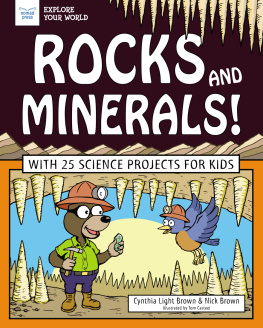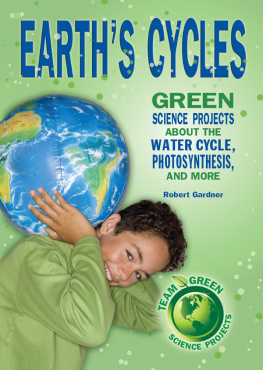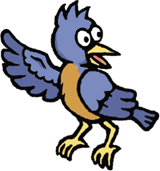Anita Yasuda - The Water Cycle!: With 25 Science Projects for Kids
Here you can read online Anita Yasuda - The Water Cycle!: With 25 Science Projects for Kids full text of the book (entire story) in english for free. Download pdf and epub, get meaning, cover and reviews about this ebook. year: 2020, publisher: Nomad Press, genre: Children. Description of the work, (preface) as well as reviews are available. Best literature library LitArk.com created for fans of good reading and offers a wide selection of genres:
Romance novel
Science fiction
Adventure
Detective
Science
History
Home and family
Prose
Art
Politics
Computer
Non-fiction
Religion
Business
Children
Humor
Choose a favorite category and find really read worthwhile books. Enjoy immersion in the world of imagination, feel the emotions of the characters or learn something new for yourself, make an fascinating discovery.
- Book:The Water Cycle!: With 25 Science Projects for Kids
- Author:
- Publisher:Nomad Press
- Genre:
- Year:2020
- Rating:3 / 5
- Favourites:Add to favourites
- Your mark:
The Water Cycle!: With 25 Science Projects for Kids: summary, description and annotation
We offer to read an annotation, description, summary or preface (depends on what the author of the book "The Water Cycle!: With 25 Science Projects for Kids" wrote himself). If you haven't found the necessary information about the book — write in the comments, we will try to find it.
Follow the path of Earths water in this full-color book for kids ages 7 to 10, packed with hands-on STEM activities and real-world connections that engage learners with earth science!
DripDropSplash! Water is essential to all forms of life. So lets learn all about it! The Water Cycle! With 25 Science Projects for Kids captures kids imaginations with a deep look at the world of water. Combining hands-on activities with history and science, The Water Cycle! invites kids to have fun learning about the water cycle, water resources, drinking water and sanitation, water pollution and conservation, water use, water folklore and festivals, and the latest in water technology.
- Science-minded projects include making a nilometer, designing a rain harvester out of plastic containers, conducting a transpiration experiment, and building a mini water wheel.
- A focus on conservation will empower students to do their part to help curb climate change and mitigate the effects of natural disasters.
About the Explore Earth Science set and Nomad Press
The Water Cycle! With 25 Science Projects for Kids is part of a set of four Explore Earth Science books that explore the earth, the atmosphere, and everything in between. The other titles in this series are Weather and Climate! With 25 Science Projects for Kids, Natural Disasters! With 25 Science Projects for Kids, and Rocks and Minerals! With 25 Science Projects for Kids.
Nomad Press books in the Explore Your World series integrate content with participation, encouraging readers to engage in student-directed learning. Combining content with inquiry-based projects stimulates learning and makes it active and alive. Nomads unique approach simultaneously grounds kids in factual knowledge while allowing them the space to be curious, creative, and critical thinkers.
All books are leveled for Guided Reading level and Lexile and align with Common Core State Standards and Next Generation Science Standards. All titles are available in paperback, hardcover, and ebook formats.
Anita Yasuda: author's other books
Who wrote The Water Cycle!: With 25 Science Projects for Kids? Find out the surname, the name of the author of the book and a list of all author's works by series.


















 Titles in the Explore Earth Science Set
Titles in the Explore Earth Science Set  Check out more titles at www.nomadpress.net Nomad Press A division of Nomad Communications 10 9 8 7 6 5 4 3 2 1 Copyright 2020 by Nomad Press. All rights reserved. No part of this book may be reproduced in any form without permission in writing from the publisher, except by a reviewer who may quote brief passages in a review or for limited educational use . The trademark Nomad Press and the Nomad Press logo are trademarks of Nomad Communications, Inc. Educational Consultant, Marla Conn Questions regarding the ordering of this book should be addressed to
Check out more titles at www.nomadpress.net Nomad Press A division of Nomad Communications 10 9 8 7 6 5 4 3 2 1 Copyright 2020 by Nomad Press. All rights reserved. No part of this book may be reproduced in any form without permission in writing from the publisher, except by a reviewer who may quote brief passages in a review or for limited educational use . The trademark Nomad Press and the Nomad Press logo are trademarks of Nomad Communications, Inc. Educational Consultant, Marla Conn Questions regarding the ordering of this book should be addressed to GROUNDWATER About 25 percent of all rainfall in the United States becomes groundwater.
GROUNDWATER About 25 percent of all rainfall in the United States becomes groundwater.  OCEANS The largest ocean on Earth is the Pacific Ocean.
OCEANS The largest ocean on Earth is the Pacific Ocean.  CLOUDS A cloud might look fluffy and weightless, but even fair-weather clouds can weigh a million pounds.
CLOUDS A cloud might look fluffy and weightless, but even fair-weather clouds can weigh a million pounds.  RIVERS Small rivers can have different namescreek, stream, brook, spring, crick, and more.
RIVERS Small rivers can have different namescreek, stream, brook, spring, crick, and more.  GLACIERS About 69 percent of the worlds fresh water can be found frozen in glaciers. We need to conserve water so theres plenty for everyone!
GLACIERS About 69 percent of the worlds fresh water can be found frozen in glaciers. We need to conserve water so theres plenty for everyone! 

 Can you guess what I am? I have been here since Earth was first created. I splash and spill. I drip and drop.
Can you guess what I am? I have been here since Earth was first created. I splash and spill. I drip and drop. DID YOU KNOW? The amount of water on Earth will remain the same forever.
DID YOU KNOW? The amount of water on Earth will remain the same forever. The oceans are full of resources . They are a source of food, energy, and materials such as salt and sand. Theyre also a highway for ships.
The oceans are full of resources . They are a source of food, energy, and materials such as salt and sand. Theyre also a highway for ships.